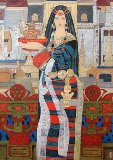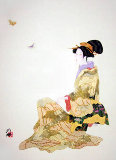



Call to the Fisherman 1963
Sadao Watanabe
Limited Edition Print : Lithograph
Size : 27.5x24.25 in | 70x62 cm
Framed : 25.75x29.25 in | 65x74 cm
Edition : From the edition of 50
-
🔥Framed Limited Edition Lithograph $$$$$$$
Year1963
Hand Signed1963 Sadao Watanabe
Condition Excellent
Framed with GlassGold Inner to Outer Black
Purchased fromOther 1990
Certificate of AuthenticityArt Brokerage
LID98309
Sadao Watanabe - Japan
Art Brokerage: Sadao Watanabe Japanese Artist: b. 1913-1996. Sadao Watanabe (July 7, 1913 – January 8, 1996), born and grew up in Tokyo, was a Japanese printmaker in the 20th Century. Watanabe was famous for his biblical prints rendered in the mingei (folk art) tradition of Japan. As a student of the master textile dye artist Serizawa Keisuke (1895–1984), Watanabe was associated with the mingei (folk art) movement. The young Watababe worked in dyers' shops, sketching patterns and dyeing clothes. In 1937, one year after Yanagi Soetsu (1889–1961), father of the Japanese mingei (folk art) movement, had established the Folk Art Museum, the 24-year-old Watanabe saw an exhibition of Serizawa Keisuke's (1895–1984) work. The event sowed the seeds of Watanabe's artistic endeavor. Few years later, Watanabe attended a study group in which Serizawa taught his katazome technique of stencilling and dyeing, which originated in Okinawa. From then on, the teacher-and-student relationship between Serizawa and Watanabe became strong and abiding. The subject matter of Watanabe's prints is exclusively the gospel rendered in the mingei (folk art) approach. Influenced by Buddhist figure prints, Watanabe placed biblical subjects in a Japanese context. In The Last Supper (1981) Watanabe depicts the disciples in kimono. On the table are bottles of sake and sushi.Watanabe uses kozo paper (from mulberry tree) and momigami (kneaded paper). The momigami paper was crumpled by hand, squeezed and wrinkled to give a rough quality to the prints. The katazome method uses traditional organic and mineral pigments in a medium of soybean milk. The protein in the milk bound the colors to the paper's surface. The use of natural materials is one of the characteristics of mingei (folk art). In 1958, Watanabe received first prize at the Modern Japanese Print Exhibition held in New York City for The Bronze Serpent showing Moses and the people of Israel. Watanabe's Kiku [Listening] (1960) was featured in the novelist James Michener's The Modern Japanese Print (1962), a book that introduced ten sosaku hanga artists to the Western audience. The Vatican Museum, the British Museum, the Museum of Modern Art in New York, the National Museum of Modern Art in Tokyo and many other leading museums in the world had exhibited Watanabe's works. During President Lyndon Johnson's administration, Watanabe's prints were hung in the White House. Listings wanted.












































